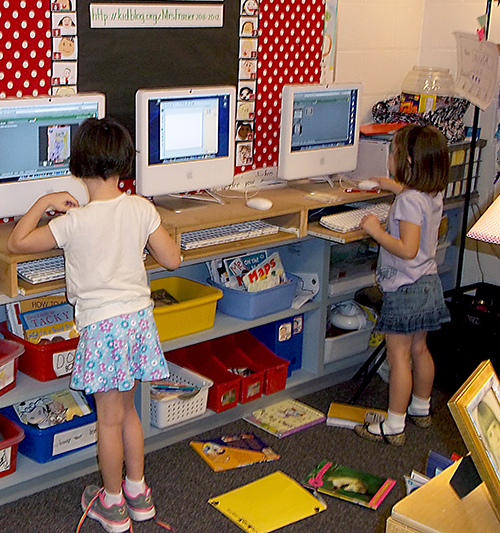Chapter 3: Digital Reading and Writing to Connect with Others
3.1 Our Classroom Community

I teach first grade in a suburban district in central Ohio. My school has some diversity. Several of the students in my classroom are second generation families in the US. Those in my class with international backgrounds speak English as their primary language and only 2 of the 5 students speak another language at home.
Our classroom community is responsive to the needs of the learners. Each day begins with a meeting where we discuss and work through our concerns and celebrate our willingness to take risks, learn from each other and support others. There’s also a lot of choice in our room: choice to move about the room, choice to choose space and tools, and choice in how to show understanding.
The only thing that is not a choice is how we will treat others. We treat others with respect and understanding. I work intentionally to teach the value of others. We read books, role play and write stories to help us understand our feelings and how our actions affect others. Respect is learned and learning to respect those who are different than ourselves requires opportunities to experience diversity and differences. While we experience diversity and differences everyday in our classroom, at school, and even in our families, we live in a larger world. where the differences are greater. Building connections with the world is our first step in learning how to live in an open and accepting community.
From Humble Beginnings Big Things Grow
Our first global connection was not planned, it all happened quite naturally, (but would not have been possible had I not explored Twitter, blogs and various tools.) One student in our class read a book about India. As he was reading the book he began to question the accuracy of the information. He asked if he could take the book home for the night and read it with his dad who was born and raised in India. The next morning he burst in the door “Mrs. Frazier my dad is from India and he said all these things are not true, only some of them.” He led the class through the book explaining what his father had said. As a class we listened, then one student said-
“Wouldn’t it be great if our class in America could talk with other classes around the world?”
and then another-
“What if we could talk about our lives with classrooms in other countries?”
Our conversation led us straight to my blog because we CAN talk to classrooms in other countries! Gathered on the carpet, teacher at the keyboard and all eyes on one 17” monitor we began to think about what we wanted to learn about people in other countries and what they might want to know about us. We worked to compose our first post (pictured below) inviting others to step into our classroom and learn with us. The anticipation in our room was growing and we were all eager to see who would be the first to reply! We didn’t worry IF someone would reply only when; we were naively confident!

As we talked about our blog reaching out to others I explained how we could stretch the reach of our blog even further by using Twitter. I opened the book beside me revealing a world map. I explained how we could talk to people all over the map by sharing the link of our blog post on Twitter.
Students questioned how a Tweet could talk to people. They didn’t understand how others read Twitter looking for interesting ideas or classrooms to connect with just as we were. To help the students understand Twitter we browsed the feed reading tweets from various places, some in other countries, marking their location on the class map. We clicked on a few links in the tweets, we saw how you could send a link to help the reader learn more. We noticed many people typed “retweet” in tweets. I explained retweeting a tweet keeps the tweet active on Twitter and builds a larger audience as the tweet then reaches out to more readers. The students were beginning to understand the reach of Twitter and we were ready to send our blog out into the world on Twitter, complete with a retweet request.

The responses to our blog post and tweet ignited a fire; students wanted to read more tweets, they wanted to share more and they wanted to know how they could interact with this new audience. The first comments on the blog were promising: Australia, New Zealand, Thailand, Guatemala, Cape Town, South Africa and Canada! Twitter and blogging were great tools for reaching out into the world, but the students wanted more, I wanted them to have access to these connections on an ongoing basis, not just when we were working as a class. In reaching out to build globally connected citizens who see the person behind the differences they would need to interact when they were inspired. They would need a different tool they could use independently, because Twitter and blogging (at this point) required my help.
As I considered the questions the kids were asking I began to think about the tools I learned about reading blogs and Twitter and just as I consider our non-digital tools, I wanted tools the students could use independently. I wanted the tools to be accessible to students without my help. I envisioned the students clamoring as they came in, running to check comments, sharing new thinking and asking more questions and learning throughout the day.

The tool would need to grow with the project and to be editable by all users. Speaking was also important to me, I knew we would be connecting with an audience that may speak English as a second language and the learners in my room were early in their language development. Both students are still learning to organize language and are often limited in their vocabulary and in written communication spelling further complicates communications. The opportunity to share orally better enables all students share thinking and ask questions. I wanted the students to be free to share without the intimidation written language may bring. It was also important to have the capability to share photos and videos to support early language learners and we would need a tool we could use from home. Having access to the tools at home would help to ensure student initiated use of the tools and parent involvement. One tool kept coming to mind, VoiceThread. VoiceThread had all these features and would lead us on a path of student driven connections.